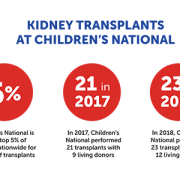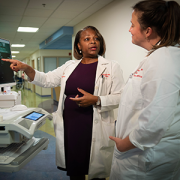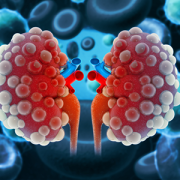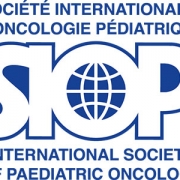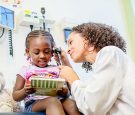New approach improves pediatric kidney cancer outcomes
 Wilms tumor, also known as nephroblastoma, is the most common pediatric kidney cancer, typically seen in children ages three to four. Compared to patients with unilateral Wilms tumors, children with bilateral Wilms tumors (BWT) have poorer event-free survival (EFS) and are at higher risk for later effects such as renal failure. The treatment of BWT is challenging because it involves surgical removal of the cancer, while preserving as much healthy kidney tissue as possible to avoid the need for an organ transplant.
Wilms tumor, also known as nephroblastoma, is the most common pediatric kidney cancer, typically seen in children ages three to four. Compared to patients with unilateral Wilms tumors, children with bilateral Wilms tumors (BWT) have poorer event-free survival (EFS) and are at higher risk for later effects such as renal failure. The treatment of BWT is challenging because it involves surgical removal of the cancer, while preserving as much healthy kidney tissue as possible to avoid the need for an organ transplant.
A new Children’s Oncology Group (COG) study published in the September issue of the Annals of Surgery demonstrated an exciting new approach to treating children diagnosed with BWT that significantly improved EFS and overall survival (OS) rates after four years when compared to historical rates. Jeffrey Dome, M.D., Ph.D., Vice President of the Center for Cancer and Blood Disorders at Children’s National Health System, was co-senior author of this first-ever, multi-institutional prospective study of children with BWT.
Historically, patients with BWT have had poor outcomes, especially if they have tumors with unfavorable histology. In this study, Dr. Dome and 18 other clinical researchers followed a new treatment approach consisting of three chemotherapy drugs before surgery rather than the standard two drug regimen, surgical removal of cancerous tissue within 12 weeks of diagnosis, and postoperative chemotherapy that was adjusted based on histology.
The study found that preoperative chemotherapy expedited surgical treatment, with 84 percent of patients having surgery within 12 weeks of diagnosis. The new treatment approach also vastly improved EFS and OS rates for patients participating in the study. The four-year EFS rate was 82.1 percent, compared to 56 percent on the predecessor National Wilms Tumor Study-5 (NWTS-5) study. The four-year OS rate was 94.9 percent, compared to 80.8 percent on NWTS-5.
“I am very encouraged by these results, which I believe will serve as a benchmark for future studies and lead to additional treatment improvements, giving more children the chance to overcome this diagnosis while sparing kidney tissue,” says Dr. Dome.
A total of 189 patients at children’s hospitals, universities and cancer centers in the United States and Canada participated in this study. These patients will continue to be followed for 10 years to track kidney failure rates. This study was funded by grants from the National Institutes of Health to the Children’s Oncology Group.



